The Café at the Frick: A Fresh Take on Victorian Elegance
- Like
- Digg
- Del
- Tumblr
- VKontakte
- Buffer
- Love This
- Odnoklassniki
- Meneame
- Blogger
- Amazon
- Yahoo Mail
- Gmail
- AOL
- Newsvine
- HackerNews
- Evernote
- MySpace
- Mail.ru
- Viadeo
- Line
- Comments
- Yummly
- SMS
- Viber
- Telegram
- Subscribe
- Skype
- Facebook Messenger
- Kakao
- LiveJournal
- Yammer
- Edgar
- Fintel
- Mix
- Instapaper
- Copy Link
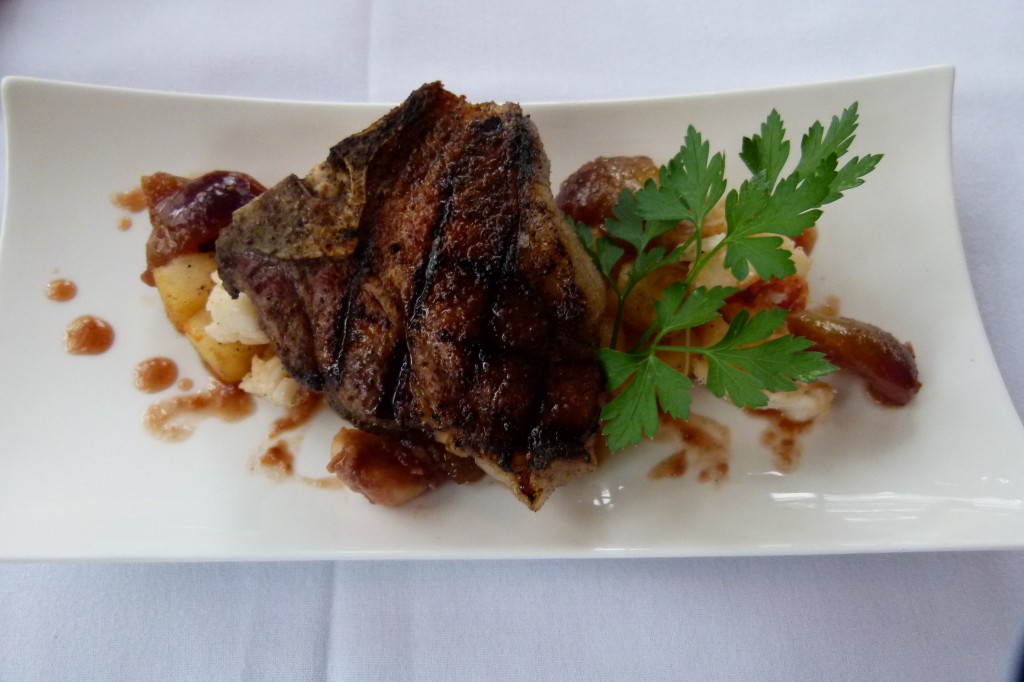
An Elysian Fields lamb chop perfectly grilled.
An afternoon lunch inside The Café at the Frick, and the city suddenly seems a hundred miles away. Our waitperson is the crème de la crème, the food presented in a rightfully leisure manner. Nature garners running credits for architecture and set design. The grounds of the Frick Art & Historical Center have never looked this good, as we watch nature outperform itself on a lazy, sentimental afternoon. Behind the pristine, glass-enclosed facade of The Café, tables are set with snowy white cloths, good silver, fresh flowers. Light coming from all directions is impressionistic, making just about any seat in the house a good one.
The kitchen and greenhouse are the heart and soul of this operation. Patterned on the precepts of visionary chef Alice Waters of the famed Chez Panisse in Berkeley, California, a philosophy of “from-scratch” absolutism pays close attention to quality, farmers’ ethics, and production processes as they relate to food inputs and purchasing decisions. Ingredients first!
Executive Chef Seth Bailey, comfortable and personable as he makes his way from table to table, knows where the chanterelles were foraged, and which farms let their animals roam. “Bailey has a passion for food that can’t be taught,” says General Manager Patrick Santillo, obviously proud of the ecologically-minded personality in the kitchen.
THE ENVIRONMENT
The eclectic Frick Café resides in what was once a garage for servants of the Fricks. The original stucco and stone structure has been seamlessly complemented by a modern solarium extension surrounded by exquisite views—a spectacular domed greenhouse, all the grander because it is still in use today; the Italianate edifice of Clayton, the Frick family home; the rolling lawns of prosperity.
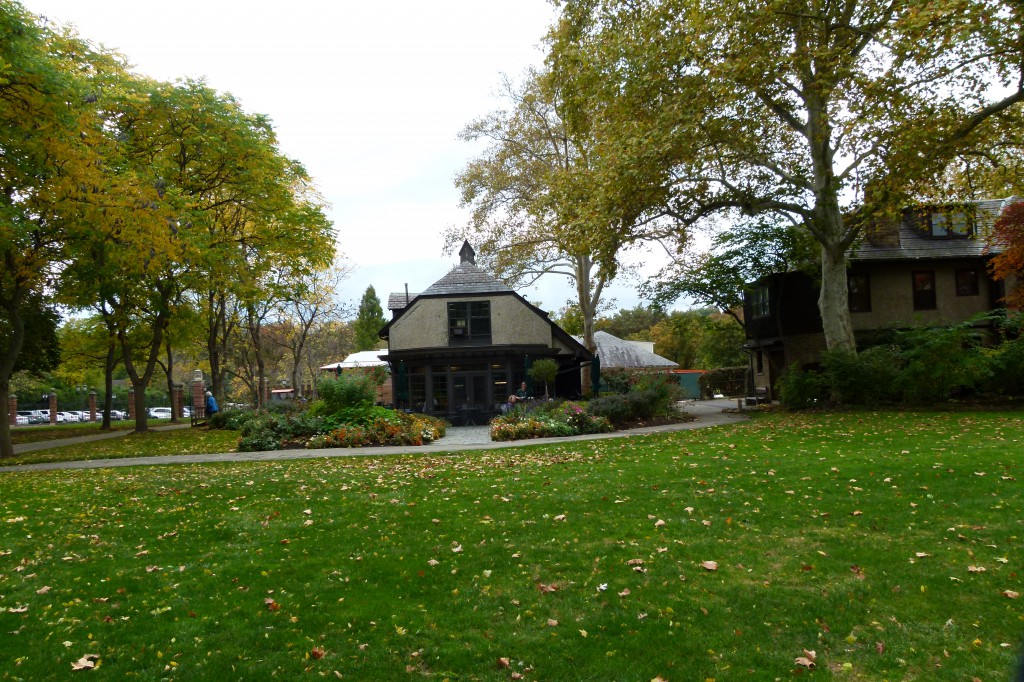
The Frick Café (ctr.) nestled among the trees and lawns of The Frick Art & Historical Center.
All of this is a local monument to the birthing pains of America’s industrial revolution. The story of the Fricks is a story that encapsulates the longstanding conflicts between capital and labor, concentrated wealth versus equitable distribution, owners versus unions, rendering an authentic if cursory glimpse back into the Gilded Age and the opulent lifestyle of industrialist Henry Clay Frick during that late-19th-century era of unfettered, laissez-faire capitalism.
In 1871, Frick was only 21 years old when he recognized the opportunities in bituminous coal and the production of coke. He borrowed money and forged a partnership with two cousins and a friend to form Frick and Company. By the age of 30, he had made his first million. The Clayton manse that we know today is the result of an 1891 remodeling done shortly after Henry was named chairman of Carnegie Steel, increasing the 11-room, two-story home into a 23-room, four-story mansion.
How lucky we are that even before the term “preservationist” was coined, Helen Clay Frick, third child to Henry Clay and Adelaide Howard Childs Frick, was already, at the tender age of 10, a budding albeit accidental preservationist. Madly in love with her childhood home, she wrote that “If all children had such a pretty room as mine, there would be none of them sad or unhappy.”
The mansion dominates the grounds. Ambushed by history, there is something sentimental about the environs, inside and out. Take a tour and you will find that many of the family’s personal possessions and artifacts serve to bring the well-preserved estate back to life.
When the Fricks moved their primary residence to New York in 1905, Helen insisted upon returning to Clayton for her debutante party, and as life continued, she maintained the house and its surrounds in pristine condition until her death in 1984. The Frick Art & Historical Center stands as the most tangible evidence of her personal legacy.
Two little boys skipping stones across some puddles stopped to peek with me into the The Car and Carriage Museum (currently under renovation), where a gentlemanly docent charmed us with a look at the old Model T’s and elegant, horse-drawn sleighs. Summertime, picture Helen with a book and sketch pad under one of the grand old oaks. Or, during a winter snow, wearing a furry cap and mittens, seated high in one of those magnificent, hand-painted sleighs.
Penn Avenue and Reynolds Street in Point Breeze frame the bucolic scenery and dreamlike quality of the estate, which envelops an entire city block. What was once the private property of a few has become quasi-communal property returned to the public, coming full circle and enriching all our lives.
THE FOOD
“Sparkling, still, or tap,” offered our server and I must say, a glass of something bubbly sounded like a good idea. We raised glasses and toasted the unsung heroes, the workers whose labor was integral to our nation’s burgeoning industrial growth.
Service in general is efficient but somewhat understated, which is to be expected in a small room with a manager always a nod away. “Like being a student teacher with your evaluator observing in the back of a classroom,” quipped my dining companion Mr. Dish.
The Café serves both luncheon and afternoon tea and doesn’t mind whether you are formally dressed or wearing jeans. In these more casual times, it preserves the core pleasures of fine dining while making optional some of the pomp and ceremony.
The intimate, 30-seat room runs crowded and bright, with plenty of plate glass windows for afternoon sun, and a patio when the weather is willing.
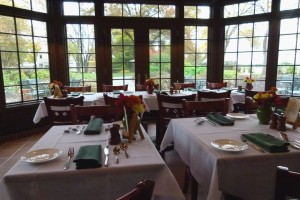
The cozy confines of the Frick Café.
The Café has discovered and maintained the perfect color for this dining establishment, a gorgeous shade of aquamarine I’d tag “Aegean” on a paint swatch. It’s rich yet comforting, like sinking into a favorite sofa with good springs. And instead of the elaborately patterned china one might imagine as the Frick’s preferred selection, the dinnerware is minimalist, simple, spare, white. It allows for a kind of modern creativity that comes from the form and suits the food. A square bowl is the perfect setting for a pleasantly sweet cup of carrot and orange soup, with tastes that resonate like two complementary shades of the same color. Chopped scallions scattered on top add a slight crunch.
Chef Bailey, known for his approach to gastronomic counterpoint, brought the recipe for The Café’s earthy she-crab soup from a stint at a seafood house in Charleston, South Carolina. Fresh vegetable stock, lump crab, crab roe (rendering the slightly orange tinge to the soup), dry sherry, and fresh cream equate little glories of civilization with the terrors of nature—all in a little cup of comfort. Why do people love creamy seafood chowders even in warm weather? “Self-explanatory,” says Bailey. “The key is fresh seafood.” As your spoon tugs at the buttery cream, you’re powerless to resist.
Visiting the cafe several times this past summer and fall I got a taste of the seasonality of The Café’s menu. Though I won’t go on about cold soups made with vegetables fresh from local vines, I can say the words: tomato, watermelon, and cantaloupe gazpachos—epiphanies before the seasons changed. On a trip back in the fall, a hot cup of butternut squash soup with a drizzle of maple syrup created a cold-weather food memory, rooted in the enduring nature of old favorites that infuse tradition with a twist.
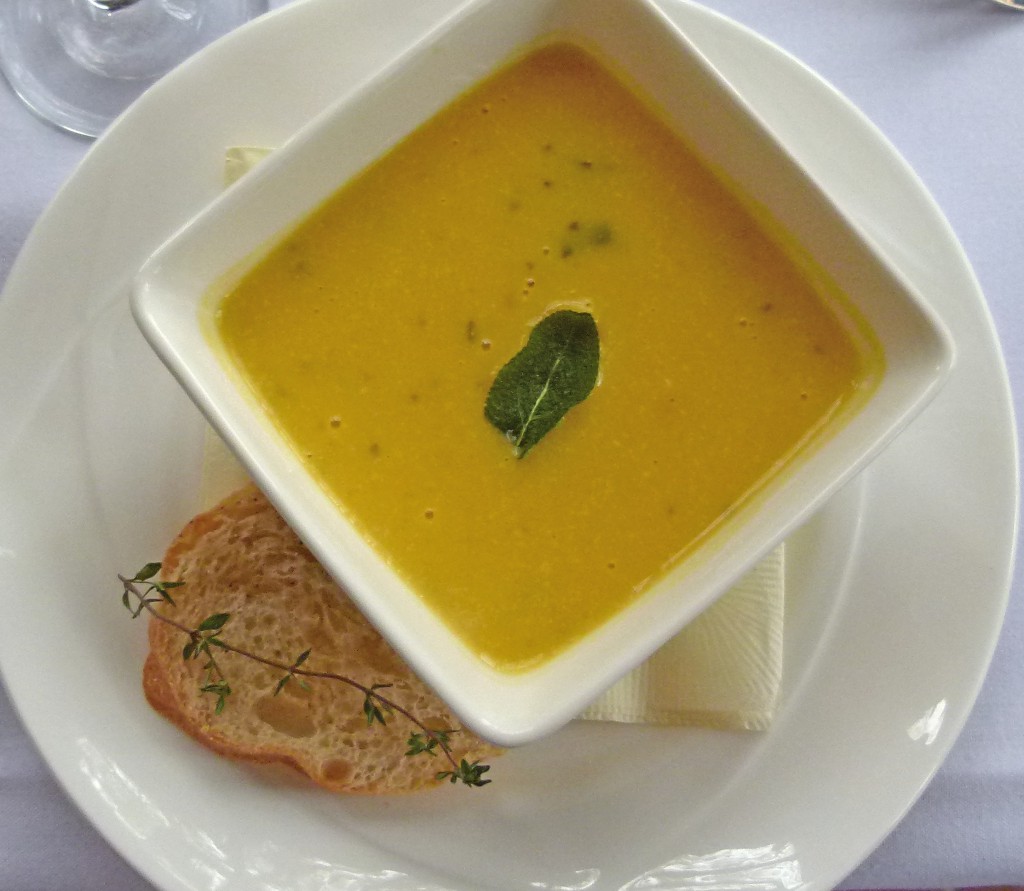
Butternut squash soup with crostini.
Before the trees chant “last call for summer,” Amish farmers regularly rap on The Café’s kitchen door with baskets of fresh tomatoes and vegetables. I had an amazing tomato salad, with Yarnick Farms’ Campari tomatoes and fragrant Thai basil plucked from the Frick’s campus garden patch, a winning foil with a Parmesan whip to balance the tomatoes’ sweetness, a purple olive vinaigrette, and crunchy wontons: the rich counterpoint that chef Bailey is all about.
Bailey’s keen sense of flavor and texture allow crunchiness to frame succulence or thrust creaminess into perfect relief. The results show up everywhere, from tiny luncheon sandwiches on three-tiered Butler trays to a wildly popular mahi mahi presented, on the day I tried it, taco-style, with cornmeal dust, chipotle crema (sour cream mixed with sauce and hot chipotle peppers), and homemade pico de gallo. Bailey uses pineapple, Brandywines, and Aunt Ruby’s German Green tomatoes. He says “the heat contrast from the hot peppers cools the sour cream base, making for great contrast with crunchy Amish cabbage shaved on a flour tortilla.”
The popular “Quiche of the Day,” under the menu’s “Salad” category, is an example of how The Café manages to make a short luncheon menu fresh versus ubiquitous, plugging in seasonal ingredients along with eggs from Miller Farms in Mercer, Pa. A little cornmeal in the dough, with butter and heavy cream (instead of only water) makes for just enough moisture in the crust. Great combinations are culinary traditions in this house. “How about ‘goat cheese and ricotta’ or ‘poblano and sweet corn with roasted garlic,’ or ‘green onion and bacon’?”
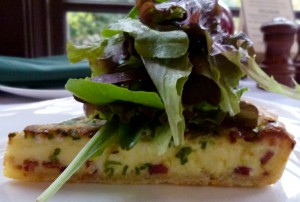
Green onion and bacon quiche topped with spring mix from The Frick’s greenhouse.
“Life is short,” I reminded my favorite malcontent, Mr. Dish, making excuses for eating butter and cream. He responded philosophically. “In the life examined, there is always food for thought.”
The dining room runs crowded and bright. By now we had gotten past the soup and were trying to pin down each elusive flavor. Nodding back to one another, we were off, down the rabbit hole, enjoying real butter and cream with tea and dessert—like characters in storybooks, “or Gatsby,” I considered.
This charming, eclectic little English tea room has an edge that saves it from being merely cute. It’s the perfect atmosphere for old-fashioned, delicious food, with a twist. Frenched chicken breast with sautéed turnips and cipollini onions, pan-seared venison medallion with truffle fingerling potatoes, creamed Brussels sprouts and pomegranate seeds. Look for the famed Elysian Fields lamb chop over lobster hash and Pontiac potatoes (grown on chef Bailey’s parents’ farm) with a fig compote and parsley garnish.
From a series of short listings under everyday menu categories—soups, salads, sandwiches, and three seasonal entrée selections—there springs an amazing, ever-changing variety of dishes to satisfy seafood, vegetarian, and carnivorous cravings. When I had the blackened grouper special, with zucchini, onion, and yellow pepper in an orange buerre blanc, I asked if the rendition was spicy. “It’s pretty mild,” said our server, and figuring this was not a difficult task, I asked for a little more heat. The result was a great piece of fish with a nice flake and plenty of heat. Delicious.
Afternoon tea, served from 2:30 to 5 p.m., is a Zen-like experience with finger sandwiches and delicate scones, cakes, jam and real English clotted cream. “We make it work and the customer benefits,” says Bailey lightheartedly. The famed, three-tiered Butler tray offered as part of afternoon tea has been evolving over the years. No longer is it just crustless chicken and egg salad sandwiches on soft white bread. There are open-faced tea sandwiches on Italian bread, and tiny brioche buns and croissants from Allegro Hearth Bakery made exclusively for The Café, with savory treats like curry crab salad and tea-soaked duck. Luxurious chocolates and darling cookies are tucked into the top two tiers. “Royal tea” includes a glass of house wine or champagne.
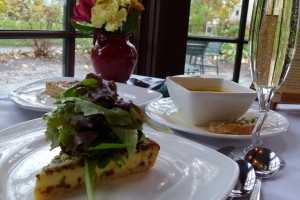
A flute of champagne goes nicely with any selection.
The Café features a small but creative offering of high quality domestic and imported wines, champagne, beer, spirits, and cocktails. Regional craft brews include Full Pint White Lightning and Tröegs JavaHead Stout. Some good cold-weather highlights, among the cocktails are French 75 (Wigle Ginever Gin, sparkling wine, simple syrup), Clementine Pomander (Wigle Wheat Whiskey, Clementine Izze, clove syrup), and a Ginger Toddy (rye whiskey and ginger tea). Martinis “with a suspicion of vermouth” and sparkling cocktails sound as crisp as the weather; the choices include a champagne mimosa, kir royale, and a kicky-sounding “belllini” (champagne and white peach puree). All encourage noshing, gabbing, mingling. Sparkling water, specialty teas (including the Frick’s own blend), and fine coffees round out the possibilities.
DESSERTS
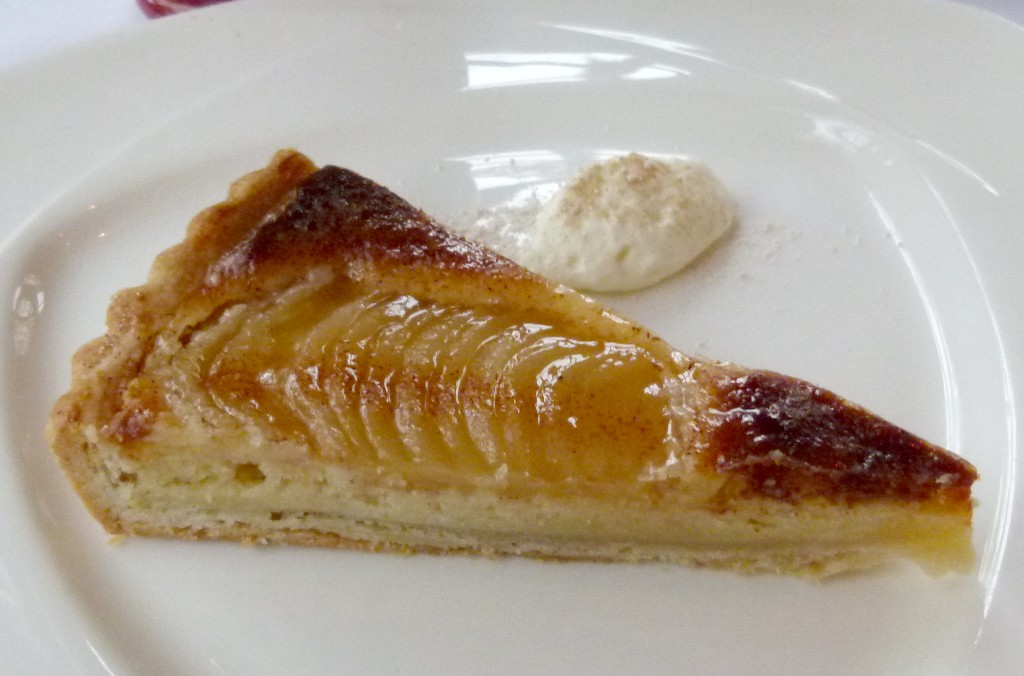
Pear almond frangipane tart.
Kudos to new pastry chef Chase Goumas, who has a hard act to follow with the recent departure of pastry chef Greg Smith (he will have spent his last day at The Café by the time you read this). “We made a good pair,” says Chef Bailey. “He is very creative and likes things to be well thought out…and his corn ice cream is the best I’ve ever tasted.” Matched with a sweet corn crepe, fresh blueberries, and orange sauce—decisions, decisions.
Goumas has made a smooth transition, says Bailey, and has already mastered the work. “Customers won’t be able to tell the difference,” he promises. Testing the statement was a good excuse for a dessert-only trip. We tried the famed croissants with English clotted cream, a blue-Stilton cheesecake with cocoa crust—and as the leaves began to thin and a sweet scent in the air warned that a cold snap was right around the bend, we devoured tarts that would make the Mad Hatter’s hat slip, from a classic chocolate pecan bourbon tart to a pear almond frangipane, sour cream cherry tart, and a surprise crème brûlée of the day.
Two sugar cookies sit sweetly on our check.
THE CHEF
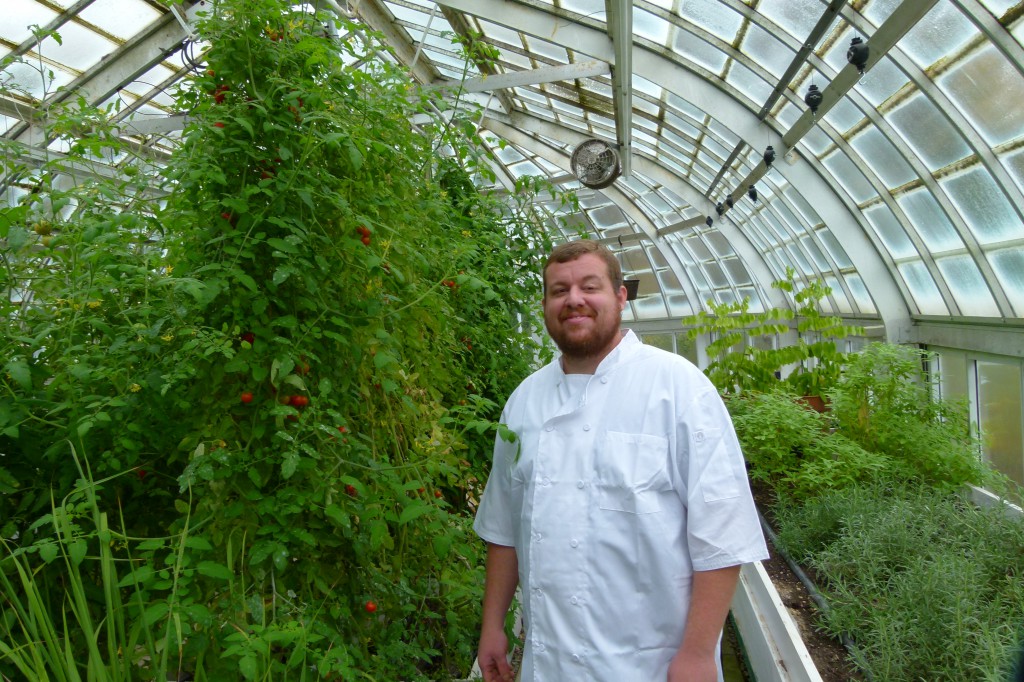
Seth Bailey in the greenhouse, next to tomato plants and happy that he has fresh local tomatoes year-round.
Executive Chef Seth Bailey’s energy and optimism are catchy. Dismiss the notion of stuffy chefs in starched toques. Bailey is entirely approachable, with a great sense of fun. When I ask him if he encounters any flak from colleagues for working banker’s hours, he laughs. “Are you kidding? The hours are one of the reasons I took this job. I think they’re envious.”
Bailey grew up on a farm in St. Marys, West Virginia. “I realize now that I knew what good food was, although I didn’t know I knew.” He started working in restaurants during high school and has been in some aspect of the restaurant field ever since. At Johnson and Wales University in Charleston, South Carolina (“a great food city,” he comments), he earned a bachelor’s degree in Food Service Management while working full-time. As part of his degree program he took a summer externship at the Charleston restaurant Poogan’s Porch. ”A busy place, heavy on the seafood, and a great learning experience. It’s where I learned to cut my teeth on what real, fresh seafood is. I remember breaking down my first 90-pound tuna, single-handedly.”
Four more years, and Bailey’s adventurous spirit took him further north for yet another change of scenery. In Charlotte, North Carolina, he rose up the ranks to sous chef at seafood restaurant Aquavina, and later its sister restaurant Lattores, a Latin-themed place, where he rounded out another four years and met his future wife.
Bailey reports that the early days of the farm-to-table movement were initially more active down south, based on sheer geography and hence, a longer growing season. When Bailey was invited to Pittsburgh for an interview at The Café at the Frick, he was nonetheless struck by the notion of having his own garden and greenhouse on site.
In February 2008, he packed a 38-foot U-Haul and drove from North Carolina to Pittsburgh, parked in front his new home in McCandless Township, and started work the following morning at The Café.
These days, Bailey still enjoys sorting fresh-cut Swiss chard, crisp, vibrant, right out of the ground; and assorted heirloom “toy box” cherry tomatoes, “each with its own little flavor.” In addition to herbs like Thai basil, oregano, cilantro, and two big planters of chocolate mint, this year the house garden focuses on edible ornamental flowers—violets, pansies, nasturtiums.
“It’s so nice to have a small, thoughtful menu, intimately focused on food,” says the chef.
“Anything you would like to tell Pittsburghers?“ I ask. Bailey—who loves everything seafood responds: “The more that’s on a shrimp when it arrives on your plate, the more likely the quality. Is the tail on the back? Legs intact? Head on? If it looks like a whole creature that hasn’t been stepped on, you’re in luck. Point being, don’t ever settle for an inferior product.”

The Frick Café, a picturesque setting.
HOURS AND VISITORS’ INFORMATION
Frick Art & Historical Center
7227 Reynolds Street
Pittsburgh, PA 15208
(412) 371-0600
TheFrickPittsburgh.org
Hours: The Café at the Frick is open Tuesday-Sunday, 11 a.m. to 5 p.m. Closed Monday. Tea service is available daily after 2:30 p.m. Reservations suggested. 10% discount for members.
Thursday evenings in December (the 4th, 11th, and 18th) The Café is open until 9 p.m., with seatings at 5:30 and 7:30 p.m. Due to the popularity of Café dinners, reservations are especially recommended.
Deborah McDonald is a Pittsburgh native who worked in the local food and hospitality industry (dropping many a plate and glass) while earning her degree in journalism. McDonald is one of Pittsburgh’s most highly respected and experienced food and restaurant writers.
Photos: Rick Handler
Share on Social Media
- Like
- Digg
- Del
- Tumblr
- VKontakte
- Buffer
- Love This
- Odnoklassniki
- Meneame
- Blogger
- Amazon
- Yahoo Mail
- Gmail
- AOL
- Newsvine
- HackerNews
- Evernote
- MySpace
- Mail.ru
- Viadeo
- Line
- Comments
- Yummly
- SMS
- Viber
- Telegram
- Subscribe
- Skype
- Facebook Messenger
- Kakao
- LiveJournal
- Yammer
- Edgar
- Fintel
- Mix
- Instapaper
- Copy Link
Follow Entertainment Central
Sign up for the EC Newsletter
Latest Stories







